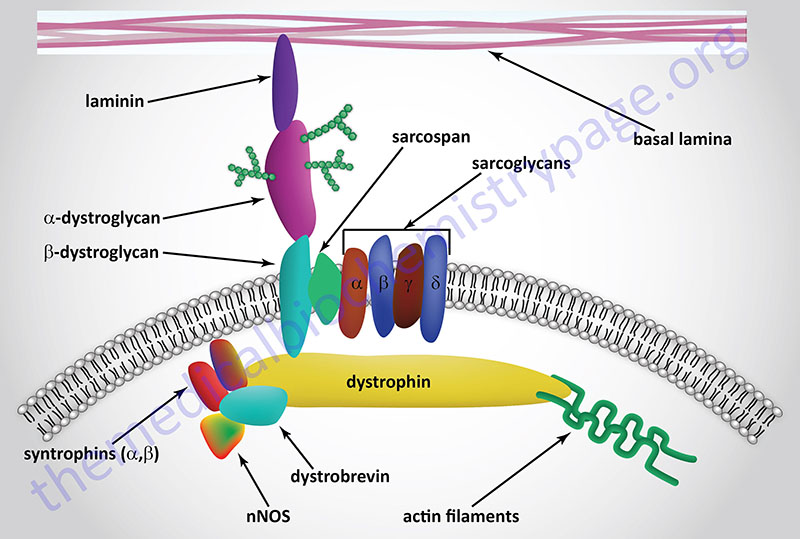Last Updated: September 25, 2024
Introduction to Myotonic Dystrophy
Type 1 myotonic dystrophy (originally abbreviated DM1 for the Latin dystrophia myotonica) is the most commonly occurring form of muscular dystrophy in adults. The disease manifests in nearly 1 in 8,000 individuals. Myotonic dystrophy is also referred to as Steinert disease.
Type 1 myotonic dystrophy is an autosomal dominant disorder resulting from the expansion of a CTG trinucleotide repeat in the dystrophia myotonica protein kinase (DMPK) gene. The DMPK encoded enzyme is also called myotonin-protein kinase. The dystrophia myotonica protein kinase is a member of the large family of Ser/Thr kinases identified as the AGC family.
The CTG repeat (CUG in the mRNA) resides in the 3′-untranslated region of the mRNA. Normal individuals have 5–37 repeats and affected individuals have repeats ranging from 50 to several thousand. Like many trinucleotide repeat disorders DM1 exhibits the genetic phenomena of anticipation which refers to the appearance of symptoms earlier and with increased severity in subsequent generations. Of note is that myotonic dystrophy is the first disorder in which the phenomenon of anticipation was demonstrated as the clinical basis of the course of the disease.
Molecular Biology of Myotonic Dystrophy
The DMPK gene (also identified as Mt-PK) is located on chromosome 19q13.32 spanning 13 kbp and and is composed of 15 exons that generate seven alternatively spliced mRNAs. The largest encoded protein (isoform 1) is 639 amino acids in length and contains an N-terminal domain that shares strong homology to the cAMP-dependent serine-threonine protein kinase family. The DMPK protein is predominantly localized at sites of neuromuscular and myotendinous junctions of skeletal muscles. In patients with myotonic dystrophy the levels of detectable DMPK in skeletal and cardiac muscle are much lower than in unaffected individuals.
The mechanism of disease development in DM1, as a consequence of expansion of the CTG triplet in the DMPK gene, is related to disruption in RNA metabolism. The expansion of the CUG repeat in DMPK RNA leads to abnormal regulation of alternative splicing events. The negative effect on RNA splicing occurs in trans. The mutant DMPK RNA is normally spliced but the presence of the expansion alters the splicing of other RNAs. These aberrant splicing effects have been identified in at least 13 different mRNAs from three different tissues.
Splicing of RNAs is an elaborate process that is regulated by a dynamic complex of RNA-binding proteins. Two proteins have been identified that exhibit altered affinities for RNA as a consequence of CUG repeats: CUG-BP1 (CUG binding protein 1) is a member of the CUG-BP/ETR-3-like (CELF) family of proteins involved in RNA splicing, RNA editing and translation; Muscleblind-like (MBNL) is the other protein and it is involved in the regulation of alternative splicing. Both proteins bind to CUG repeats but only MBNL binding is affected by the length of the repeat. These two proteins antagonistically regulate alternative splicing. In the presence of mutant DMPK RNA there is a gain-of-function in CUG-BP1 and a loss-of-function in MBNL.
Several of the mRNAs found to be affected by the altered RNA processing events correlate well with the symptoms seen in DM1. These include the insulin receptor (resulting in insulin resistance and diabetes), cardiac troponin T (leading to cardiac abnormalities), voltage-gated chloride channel 1 (CLCN1, resulting in myotonia), as well as RYR1 (ryanodine receptor 1), MTMR1 (myotubularin related protein 1; is a member of the Tyr/dual-specificity phosphatase superfamily) and ATP2A1 (ATPase, Ca2+ transporting, cardiac muscle, fast twitch; also called SERCA1) leading to muscle wasting.
Myotonic Dystrophy type 2, DM2
The identification of patients thought to be suffering from myotonic dystrophy but not harboring triplet expansions in the DMPK gene, led to the classification of the disorder as dystrophia myotonica 2 (DM2), more commonly referred to as type 2 myotonic dystrophy (DM2). DM2 results from the expansion of a tetranucleotide, CCTG, present in intron 1 of the zinc finger protein 9 (ZNF9) gene located on chromosome 3q21.3.
The ZNF9 mRNA encodes a protein with 7 zinc finger domains and it is thought to be an RNA-binding protein. The ZNF9 gene is also known as the cellular retroviral nucleic acid-binding protein 1 (CNBP1). The range of expansion of the CCTG repeat in DM2 patients is quite broad ranging from 75 to 11,000 repeats with the mean repeat size being 5,000. In DM2 patients the expanded ZNF9 mRNA accumulates in distinct foci within the nucleus.
Clinical Features of Myotonic Dystrophy
As the name of the disorder implies the characteristic clinical manifestation in DM is myotonia (muscle hyperexcitability) and muscle degeneration. Affected individuals will also develop insulin resistance, cataracts, heart conduction defects, testicular atrophy, hypogammaglobulinemia and sleep disorders. Symptoms of myotonic dystrophy can manifest in the adult or in childhood. The childhood onset form of the disease is often associated with intellectual impairment. In addition, there is a form of the disease referred to as congenital myotonic dystrophy. This latter form of the disease is frequently fatal and is seen almost exclusively in children born of mothers who themselves are mildly affected by the disease. In congenital DM the facial manifestations are distinctive due to bilateral facial palsy and marked jaw weakness. Many infants with congenital myotonic dystrophy die due to respiratory insufficiency before a proper diagnosis of the disease is made.
Manifestation of DM1 initially involves the distal muscles of the extremities and only as the disease progresses do proximal muscles become affected. In addition, muscles of the head and neck are affected early in the course of the disease. Weakness in eyelid closure, limited extraocular movement and ptosis results from involvement of the extraocular muscles. Many individuals with DM1 exhibit a characteristic “haggard” appearance that is the result of atrophy of the masseters (large muscles that raise and lower the jaw), sternocleidomastoids (large, thick muscles that pass obliquely across each side of the neck and contribute to arm movement) and the temporalis muscle (muscle involved in chewing).

